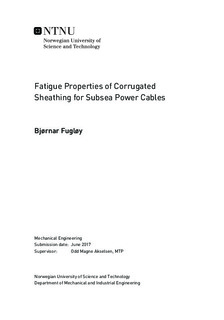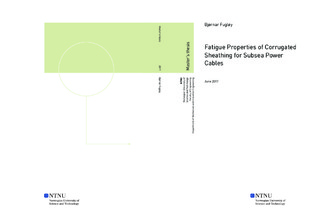| dc.description.abstract | A high voltage subsea power cable consists of several different layers with different purposes. One layer is a metallic tubular sheathing with the main purpose to act as a moisture-blocking barrier to prevent moisture ingress towards the cable core. Unlike a static cable, which normally utilizes a smooth tubular sheathing, the dynamic cable is exposed to various hanging configurations and fatigue loading. Hence, a need for a more flexible but also fatigue resistant sheathing has arose. Thus, metallic corrugated tubular sheathing (MCTS) has been introduced as a candidate, due to high flexibility, good mechanical strength and favourable fatigue resistant.
This master thesis investigates, on commission from Nexans, a MCTS with respect to how various geometrical parameters, that is corrugation pitch (P), amplitude (A), sheath thickness (t) and helical inclination angle influences the developed strain along the corrugation geometry. The obtained results can be utilized as a parameter to predict the MCTS fatigue properties.
In this thesis, the MCTS was 3D modelled and parametrized, thereafter a finite element approach was utilized to expose the MCTS models to static axial and bending analysis and quasi-static four-point bending analysis. Variations in local geometry parameters were analysed and evaluated based on developed strain. When changing the different geometrical parameters, variations in developed strain occurred. Local developed strain values were further compared to global strain values obtained by exposing a smooth tubular sheathing to similar boundary conditions as the corrugated models.
Finite element analysis (FEA) indicated that the most suitable corrugation geometry for fatigue life based on global and local strain development fields in the corrugation was a MCTS inherent with a thin wall thickness, a low P/A ratio and a high A-value. Considering the most suitable corrugation wave pattern, the FEA indicated that both annular and helical were favourable. However, if selecting a helical wave pattern, the helical inclination angle should remain small, due to the presence of a relatively high shear strain sensitivity when introducing a helical wave pattern.
A prime design example considering fatigue life, based on the FEA results, may be a MCTS comprising of t=0.7mm, P/A=2.0, A=5.0mm and a corrugation geometry holding either an annular or helical wave pattern, where the helical pattern should hold a low inclination angle. | |

